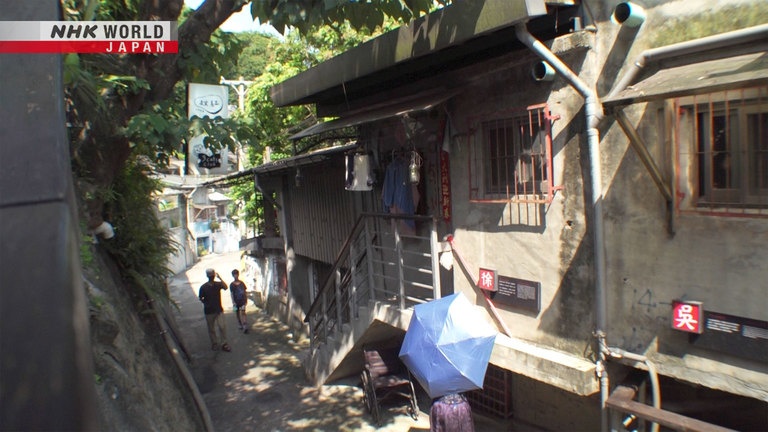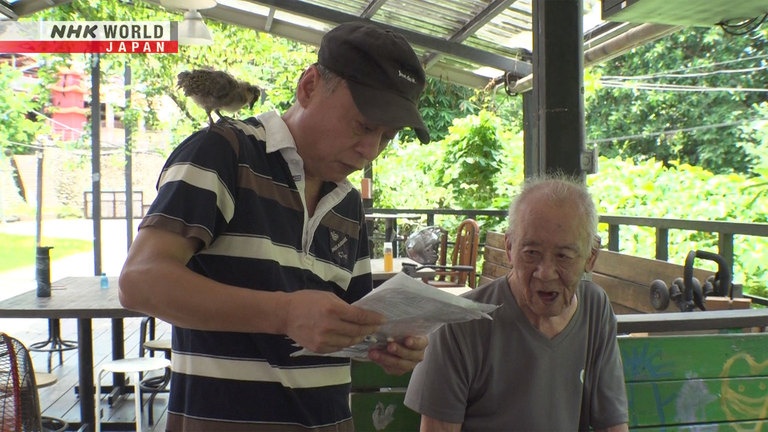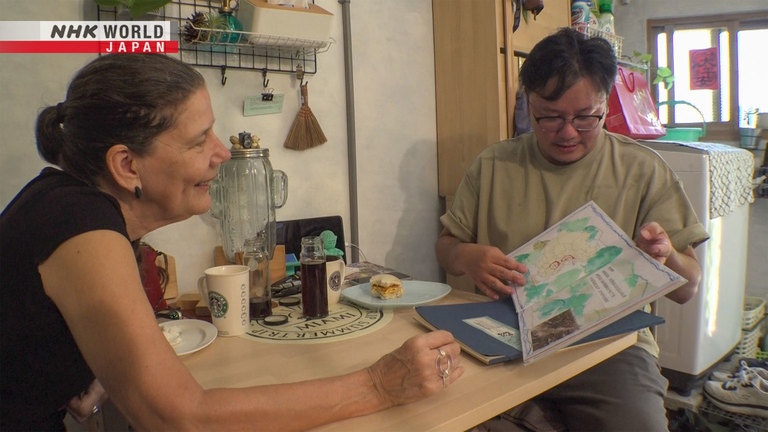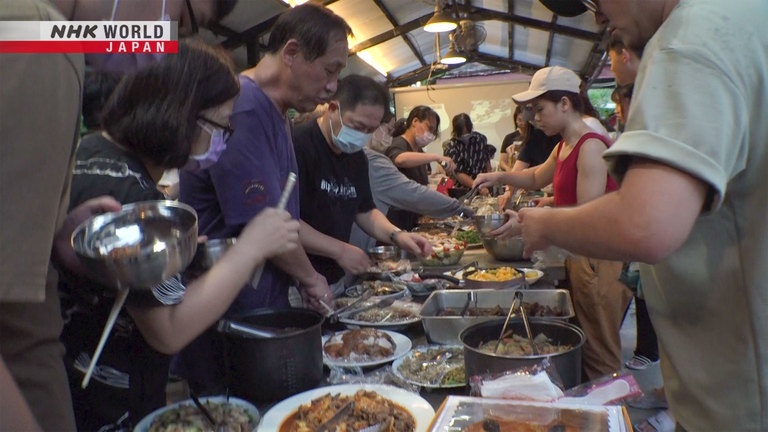Artistic Coexistence in Treasure Hill: Taiwan
Treasure Hill is a community and artist village run by the city of Taipei since 2010. Originally a settlement built by retired soldiers and immigrants, the buildings were deemed illegal and unsafe, and condemned to demolition. Twenty years of demonstrations and activism by locals persuaded the city to preserve the area, and it was turned into an "artist village" with studios and exhibition spaces. 22 artists from Taiwan and abroad live alongside ordinary residents. Meet the locals working hard to preserve the community's history.




Transcript
The metropolis of Taipei, Taiwan.
In the center of the city lies Treasure Hill, a neighborhood with an unusual history.
"Let's walk together.
Free guide."
In 2010, it opened as a city-run artist village, and soon became a popular tourist destination.
"I just opened in March."
Over the years, the village has provided a home to more than 500 local and global artists.
The area was originally a settlement of retired soldiers and immigrants.
In the 1980s, the government declared the homes illegal and began tearing them down.
"This is when the pushback began.
Government folks came to talk."
Residents spent twenty years protesting the demolition.
"The council said that for Taipei to be an
international city, we had to go."
"It was a long, hard fight."
After long talks, the city settled on an arrangement to run the artists' community,
while the residents remained in place.
Living alongside artists,
how will the residents of Treasure Hill maintain and protect their way of life?
Around 2.5 million people live in Taipei.
Just five kilometers south of the center, the city has a very different feeling.
A road with a scattering of murals...
... leads to a richly verdant community.
This is Taiwan's first "artist-in-residence" village, Treasure Hill.
Around half of the 80 or so buildings are used as studios and galleries for artists.
There are currently 17 Taiwanese and five foreign artists in residence here.
Those who wish to live here must undergo a review process
by the Taipei department of cultural affairs.
If accepted, they may stay up to ten years paying only a nominal rent.
Visitors, meanwhile, can enjoy the work of the village's artists in a historical setting.
Being close to Taipei's center, Treasure Hill draws nearly 400,000 people each year.
Alongside the artists live the original residents of Treasure Hill.
Everyone looks forward to the twice weekly karaoke sessions in the community center.
Hsu Sheng Ching takes her turn, wearing an apron.
She was born and raised here and residents regard her as a motherly figure.
She heads out to the communal vegetable garden.
"We eat what's here.
Not a lot of choice."
"But you can eat anything
if you try. Take a look."
"This one is Chinese spinach."
Over 30 varieties of vegetable are grown, chemical free.
There's something to harvest in every season.
Residents also opened a general store ten years ago.
Hsu runs the store, and sells her handmade goods too.
Tea made from smoked plums and hawthorn helps digestion and circulation
and is said to prevent heat exhaustion.
Lemon vinegar is thought to stave off osteoporosis.
Both are made from the garden's communal produce.
Hsu's days are spent caring for her niece, and cooking with vegetables from the garden.
"Sweet potato leaves."
Her family was one of the first to move to the area.
- "Since your grandmother's time?"
- "Yeah, in the upper temple."
Hsu's grandmother lived in Treasure Hill Temple.
It was built by immigrants from Fujian province on the mainland, who came to Taiwan in the 1600s.
A water source was established behind the temple during Japanese rule, and military barracks were built.
It later became a base for the Chinese Nationalist Party's troops from the continent.
In the late 1940s, six families moved into part of the barracks, and the current community was born.
Retired soldiers and immigrants from the continent began to move in, slowly building onto the original structures.
Eventually the settlement housed 200 families.
However, that bustling community has since dwindled to a mere 19 households.
Many are over the age of sixty.
Hsu Hung Shu is 91 years old.
He lives alone but visits the community center every day.
"How long have you lived here?"
"About 70 years."
"I love the atmosphere.
I'm a lonely old man."
"They look out for me.
Provide food as well."
"That's what we're here for."
Chan Chih Hsiung was born and raised here.
It was his idea to open the general store.
The store displays a set of principles.
"This is more than a store.
It connects the generations."
"Food for the elderly.
All lives are precious. We're here for each other."
As the residents grew older, Chan wanted to protect them.
He took a position as community leader 20 years ago.
His family is one of the six that moved into the empty barracks.
"You have so many!"
"Grandpa left them to me.
I look at them when I have time."
"Grandpa grew and sold vegetables."
"He's 90 in this photo.
Too old to work much."
His grandfather, Chan Wan Chi, raised him in place of his father.
To support their extended family of eleven, he grew vegetables and sold them in the streets.
"Grandpa and Uncle built our home."
"They fixed up an old Japanese
military building."
"They earned a little, made additions,
added a bathroom."
"A little bit at a time."
Chan and Hsu are the only descendants of the original six families who still live in the community.
"It's living history."
"Those of us here today live
the same way as those before us."
"It's why I took
the leadership position."
It was the looming threat of his home's demolition that hardened Chan's resolve to take the job.
Taipei's government ruled the buildings illegal and unsafe,
and ordered the settlement torn down to improve the cityscape.
Residents reached out to civil activist groups and began a protest.
Experts and scholars declared to community, a living historic monument.
Workshops were held with a view to preservation,
and long negotiations with the council began.
"Some official drove past in their car."
"They looked out and thought, 'What a mess!'"
"The council said that for Taipei to be an
international city, we had to go."
"But a lot of people were living here.
They couldn't demolish it right away."
"It was a long, hard fight."
"Did you protest?"
"Of course!
The authorities were so violent."
In 2004, the city officially recognized the settlement
as a historic structure to be preserved and maintained.
Repairs were made, and rental agreements arranged with residents.
The artist village was established, where residents would live side by side with artists.
Meanwhile, Chan set up an NGO to ensure that residents could maintain their way of life.
The group carries out all kinds of activities to keep local life vibrant.
In addition to the communal vegetable garden, the residents are building chicken coops.
The plan is to produce eggs for people to share.
Everything here is handmade.
Residents design their own lives.
Chan even returned to university to study social-environmental design.
Other projects focus on living alongside the village's artists.
Like this weekly art class.
Today's teacher is artist Chu Shu Wan, who's lived here for nine years.
The class is learning about making art that draws on sunlight.
"We're going to develop photos."
"Shine light on film and the covered
areas turn white."
"It produces a reversed image."
- "The white parts have color?"
- "They will actually turn blue."
Hsu always takes part, along with her niece.
Sunlight is used to make an image of the baby's feet.
After the art class, Chu returns to her own work.
This is her studio.
At art school, she studied industrial art that incorporated plants.
The verdant surroundings of this community have been an inspiration to her.
It's an important place for Chu.
"These are garcinia leaves."
"Bark from a eucalyptus."
"It sheds bark every year and
it makes a great black dye."
"Everything I need is here.
It's a wonderful place for me."
"If I want to make something
the materials are at hand."
- "You want to stay?"
- "I do."
In six months, Chu's contract with the city will end.
Such affordable rent for a living space and studio in the city center has many artists eager to live here.
"I use roadside plants or moss."
"Stones from dismantled homes."
"Items that others deem unimportant."
"I turn them into jewelry."
"I make them precious."
"I hope it inspires people to
reexamine their own surroundings."
"There's so much value
in the things around us."
Her current project involves making earrings from stones and moss she found around Treasure Hill.
In our pursuit for a more convenient life, some things are forgotten.
Chu hopes her work reminds us of what is lost.
Some artists enjoy their stay so much that they come back to visit
after their lease agreement ends.
"Residents made these in
my studio as public art."
"They each made one."
"That one's mine!"
Lu Hsueh Fen arrived in 2010 and worked here for ten years.
She now has a studio elsewhere in Taipei, but still comes to visit every week.
"She taught me how to design
and make these."
- "My personal cups."
- "Everyone made their own."
"I was so sad to leave here."
"But it's lovely to come back."
"I was here for ten years.
That's a very long time."
"The folks here are like family."
"We planted herbs, painted china,
and all chatted together."
"It's how you build relationships."
Artists often isolate themselves when they work,
and having tea together allows them to connect.
It's a relaxing moment that they both enjoy.
"Good to see you!"
- "Morning!"
- "Morning."
Artist, Lu Shiang Fu became a resident after completing a short three-month stay here.
"You coming today?"
"Yes, but I don't know what
to make. I need to go shopping."
"Why's it so hot?"
- "The AC is on?"
- "Yeah."
"Still hot though."
"Take care!"
At art school, Lu studied the effect of art on people.
The village proved a perfect location to dive further into his research.
Since becoming a resident, he regularly invites artists to his home.
His latest guest is Dutch curator Sasha Dees, who's visiting Taiwan to hold an exhibition.
He was the first villager I actually met.
He serves her a mantou steamed bun sandwich, a popular home meal in Taiwan.
Lu discusses creative ageing with Dees, a movement that's growing in the US and Europe.
It uses art to bring positivity to the experience of growing older.
Creative ageing.
It means the elderly can - can make their,
they can do painting, do dancing, can do all kinds of art, do all kinds of art.
Yes, it's important, yes? I think it's good to work with art and keep your mind running.
Lu takes out a book he worked on recently.
This is the old soldier, the old guy, old soldier. I teach old people.
His life story, a picture book and he was born in Hubei in China,
and go to Beijing, Shanxi, and go to Taiwan.
When he was a child, China is very peaceful.
When you ask him, when he was ten, what happened with the war,
to leave his mother, and he never-never see again.
- I see, about his life.
- Yes.
"This is an inspiring place.
Many elderly people to teach about art."
"I'll start my PhD in September."
"An academic study on whether
art helps the elderly."
"Does it help mitigate dementia
or similar conditions?"
The residential agreement with Taipei City will end in 2030.
It's still not clear if the residents can renew the contract in seven years time.
The community has gathered to discuss their future.
"Let's see.
'What will the future be?'"
"Let's hear from
whoever wrote 'low-key.'"
"Too much attention draws envy.
People could try to take over."
"I worry that will destroy
the culture we've nurtured here."
"So I proposed 'low-key.'"
"I think 'low-key' won't let us
create the future we want."
"I wrote 'garden.'
Because I think of this as a park."
"We have mountains, and water."
"We offer a unique landscape
not found elsewhere in Taipei."
"It's somewhere visitors can
reexamine their ideas of a city."
"I want to build our future
around the idea of a garden."
There were once 175 similar communities of former soldiers and immigrants across Taipei.
Today, the majority have vanished, having been turned into parks or residential blocks.
"This is our school.
We played in our river."
"A river, a vegetable garden.
All of it is our garden."
"Gardens all around.
It's a fairy-tale landscape."
"'A little stream by our home,
with a mountain behind.'"
"Life is very hard."
"A happy childhood is key to
surviving when it gets you down."
"Those memories are
what keep us going."
The settlement's communal kitchen.
Residents and artists cook together here.
They're preparing for the bimonthly potluck.
Everyone brings a dish, and settles in for a good catch-up.
"Don't put it there."
- "Another table?."
- "No, we're fine."
- "I wiped it."
- "Looks good!"
These get-togethers started 20 years ago.
Chan suggested them during the height of eviction negotiations with the government.
It was a way to unite residents.
Now an artist village, Treasure Hill's potluck often brings over fifty people together.
Residents and artists alike enjoy the cheerful event.
Everyone's dishes are laid out together.
"Is it too hard to eat?
There's porridge."
"Wash your hands over there."
"I spend a lot of time thinking
about this message."
"Our lives have as much value as the artists'."
"We all have our stories."
"Artists and residents - we're all human."
"I hope we're still here in 2030."
"And that things have improved."
Residents hope that the village will become a hometown for artists too,
and are finding ways to build new memories together.
A new life begins in Treasure Hill.
"What a cute chick!
Adorable."
"It's okay, don't be afraid."
"Born last night.
Its first day alive."
"It only hatched last night."
As the store's principles declare, Treasure Hill is a place that connects generations.
Residents are determined to keep that history alive.